#St Alphege
Text
19th April
St Alphege’s Day

The Martyrdom of Alphege, Easter Day, 1012. Source: Alamy Stock Photos
Today is St Alphege’s Day. Alphege was Archbishop of Canterbury during the reign of King Aethelred the Unready, and was a major political figure at the English court in Winchester. The latter part of Aethelred’s reign was dominated by successive Viking attacks that his corrupt and ineffective regime could only partially control by bribery. In 1012, Alphege was captured during a Viking raid on Canterbury and he was carted off to Greenwich by the Scandinavians who hoped that Aethelred would pay handsomely for the safe return of his leading churchman. This was not to be. One night the frustrated Northmen dragged Alphege into their dining hall and, drunk, they began to pelt the bishop with ox bones, eventually killing him. The murderers initially refused to release Alphege’s body for burial, declaring that this would only happen when a dead piece of timber onto which his blood had spilled sprouted into life. Allegedly it did the following day, leading to the mass conversion of the raiders to Christianity and assuring Alphege’s sainthood at the same time.
On this day in 1824, the charismatic but ‘mad, bad and dangerous to know’ George Gordon, Lord Byron died. A promiscuous and bisexual bohemian, Byron scandalised early nineteenth century polite society but fascinated it too. He died of marsh fever in Missolonghi in Greece, characteristically trying to raise a volunteer army to help the Greeks win their independence from the Ottoman Turks. His ghost supposedly still swims the length of the Byron Pool in Grantchester, outside Cambridge.
0 notes
Text
Within the Octave of the Patronage of St Joseph, Notre-Dame de Fourvière Basilica / Our Lady of Lyons, France (1643) and the Saints for 19 April
Friday in the Third Week of Easter
Within the Octave of the Patronage of St Joseph
Notre-Dame de Fourvière Basilica / Our Lady of Lyons, France (1643) – 19 April:HERE:https://anastpaul.com/2021/04/19/notre-dame-de-fourviere-basilica-our-lady-of-lyons-france-1643-and-memorials-of-the-saints-19-april/
St Alphege of Winchester (c 953–1012) ArchBishop and Martyr, Monk, Hermit, Abbot, Teacher,…
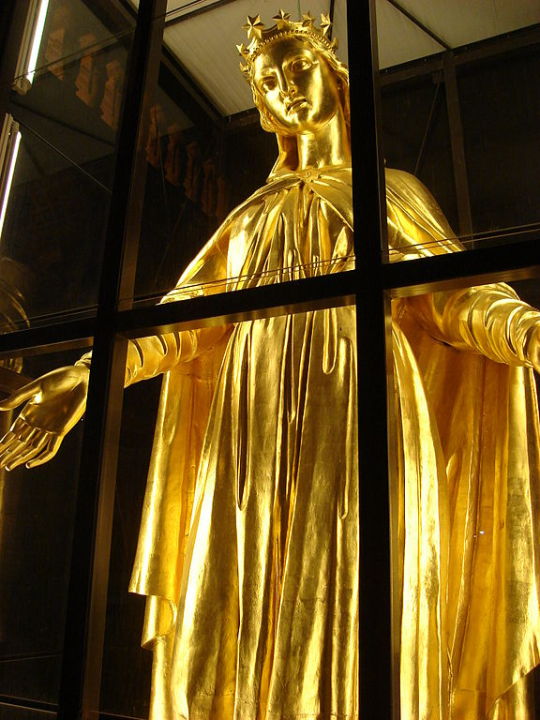
View On WordPress
10 notes
·
View notes
Text
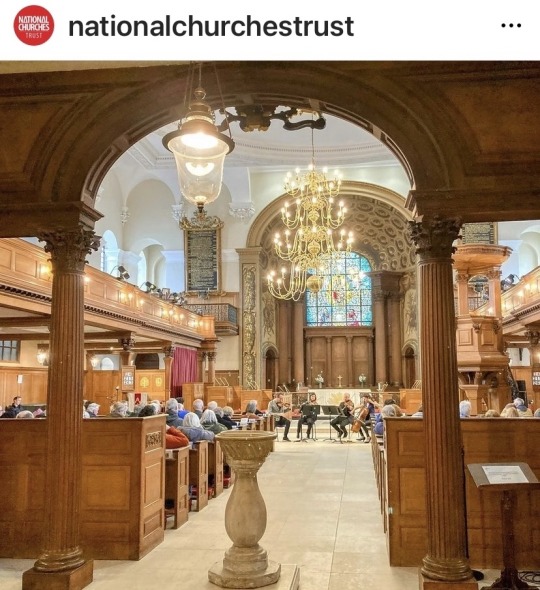
Wonderful St. Alphege in Greenwich again!
12 notes
·
View notes
Text

The Icon of Holy Martyrs of the Armenian Genocide
More Saints of the Day April 19
St. Alphege
St. Alphege of Canterbury
St. Crescentius
St. Emma
St. Expeditus
St. Gerold
St. Hermogenes
Bl. James Duckett
St. . Anthony Pavoni
St. Timon
St. Ursmar
St. Vincent of Collioure
#catholic#saints#blessed#martyrs#pray for us#holy martyrs of armenian genocide#iconography#moresaintsoftheday
3 notes
·
View notes
Text
Deerhurst - Anglo-Saxons and puritans
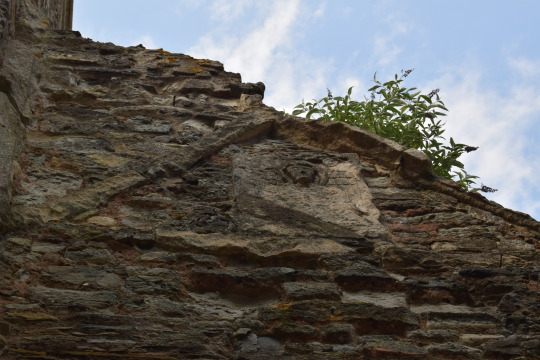
Deerhurst in Gloucestershire is a magical place. It is probably the most famous Anglo-Saxon church in England, probably because of the survival of this angel, which is not easy to spot, being high up, outside, behind the chancel, and hidden at the side of an alcove, perhaps the reason it has survived so long. The church is full of tell-tale Anglo-saxon features, such as the use of triangles:
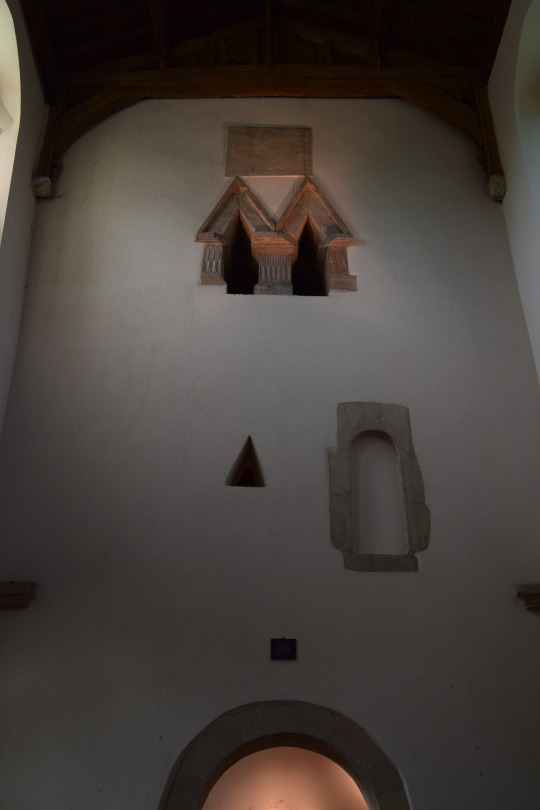
Its font is glorious, dating from 800 AD:

Thrown out by the puritans in 1653, it has one of the many font survival stories attached to it. It was recovered in two pieces from a farmyard and a local pub in the mid-19th century. How could anyone have objected to such a beautiful object?
My ire against these philistines abated just a little when I saw there was a rare survival of an Elizabethan-style arrangement of pews so as to receive communion puritan-style on all sides around a table placed in the centre of the chancel, not at the East end.


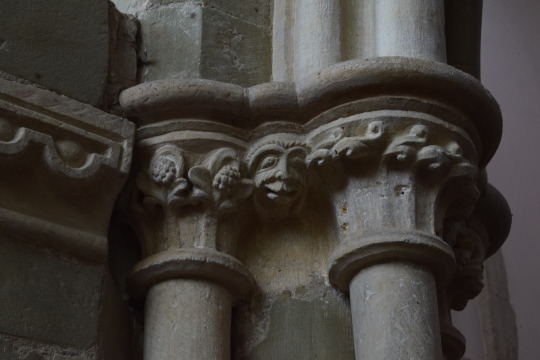
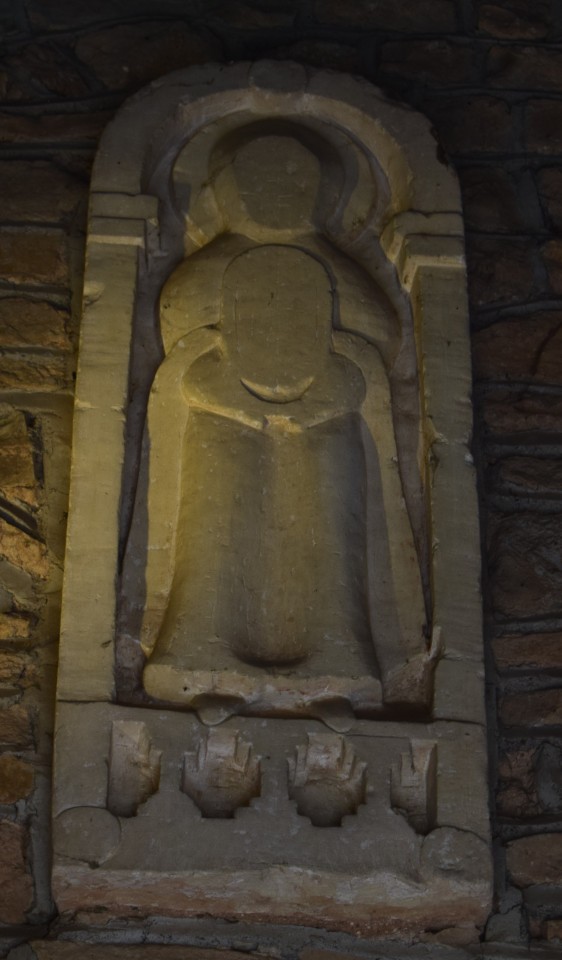

15th century stained glass window to the martyr St Alphege, who began his career at Deerhurst in 953AD:
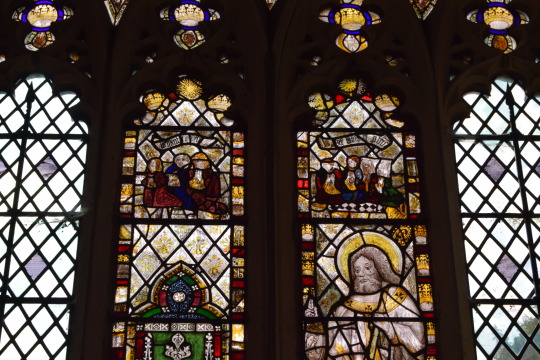
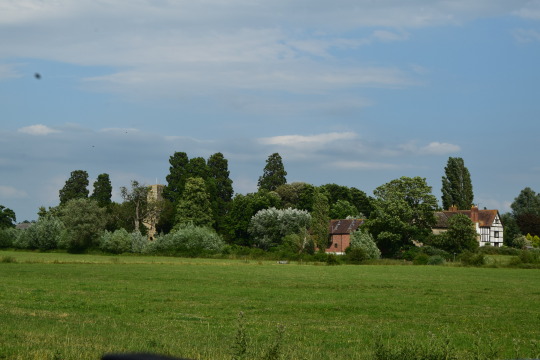
And its all in a beautiful setting by the river Severn:
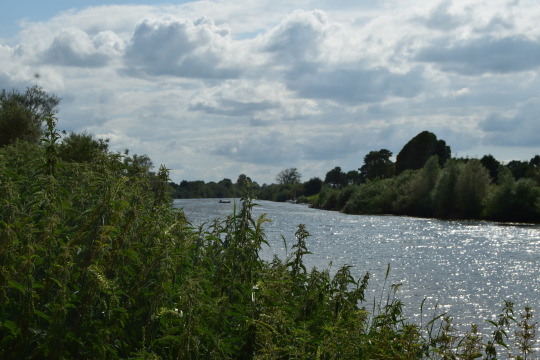
4 notes
·
View notes
Text

SAINTS OF THE DAY FOR MAY 19
STS. PARTHENIUS AND CALOGERO, MARTYRS ON THE VIA APPIA
Bl. Peter Wright, 1651 A.D. Jesuit martyr in England. Born in Slipton, Northamptonshire, England, Peter converted to Catholicism and was given preparation for the priesthood in Ghent and Rome. Entering the Jesuits in 1629, he ministered to English soldiers in Flanders and accompanied Sir Henry Gage back to England. He also served as a chaplain to the Royalist army during the English Civil War. After the war, he was arrested at the home of the Marquis of Winchester during the oppression of Catholicism by Oliver Cromwell and was put to death at Tyburn.
Bl. Alcuin, 804 A.D. Benedictine scholar and counselor to Charlemagne, sometimes called Alcuin of York. He was born in York, England, circa 735 and became a monk in the Benedictine Order in York. Ordained a deacon, Alcuin became headmaster of the cathedral school. He went to Rome and then met Charlemagne at Parma. Charlemagne invited Alcuin to become the minister of education for the Frankish court. Alcuin also founded a school and tutored the emperor. Upon retiring from the court, he became the abbot of St. Martin of Tours Monastery, reforming the house with St. Benedict of Aniane. Alcuin was listed in martyrologies as a Blessed. He was known for his holiness and scholarly wisdom, writing theological and liturgical treatises, and for his contributions to the so called Carolingian Renaissance.
ST. PETER CELESTINE V, POPE (PIETRO DEL MORRONE)
ST. URBAN I, POPE
ST. IVES, PRIEST, ADVOCATE OF THE POOR
ST. CRISPIN OF VITERBO, CAPUCHIN
St. Dunstan, Patron of armorers, goldsmiths, locksmiths, and jewelers. Born of a noble family at Baltonsborough, near Glastonbury, England, Dunstan was educated there by Irish monks and while still a youth, was sent to the court of King Athelstan. He became a Benedictine monk about 934 and was ordained by his uncle, St. Alphege, Bishop of Winchester, about 939. After a time as a hermit at Glastonbury, Dunstan was recalled to the royal court by King Edmund, who appointed him abbot of Glastonbury Abbey in 943. He developed the Abbey into a great center of learning while revitalizing other monasteries in the area. He became advisor to King Edred on his accession to the throne when Edmund was murdered, and began a far-reaching reform of all the monasteries in Edred's realm. Dunstan also became deeply involved in secular politics and incurred the enmity of the West Saxon nobles for denouncing their immorality and for urging peace with the Danes.
When Edwy succeeded his uncle Edred as king in 955, he became Dunstan's bitter enemy for the Abbot's strong censure of his scandalous lifestyle. Edwy confiscated his property and banished him from his kingdom. Dunstan went to Ghent in Flanders but soon returned when a rebellion replaced Edwy with his brother Edgar, who appointed Dunstan Bishop of Worcester and London in 957. When Edwy died in 959, the civil strife ended and the country was reunited under Edgar, who appointed Dunstan Archbishop of Canterbury. The king and archbishop then planned a thorough reform of Church and state. Dunstan was appointed legate by Pope John XII, and with St. Ethelwold and St. Oswald, restored ecclesiastical discipline, rebuilt many of the monasteries destroyed by the Danish invaders, replaced inept secular priests with monks, and enforced the widespread reforms they put into effect. Dunstan served as Edgar's chief advisor for sixteen years and did not hesitate to reprimand him when he thought it deserved. When Edgar died, Dunstan helped elect Edward the martyr king and then his half brother Ethelred, when Edward died soon after his election. Under Ethelred, Dunstan's influence began to wane and he retired from politics to Canterbury to teach at the Cathedral school and died there. Dunstan has been called the reviver of monasticism in England. He was a noted musician, played the harp, composed several hymns, notably Kyrie Rex splendens, was a skilled metal worker, and illuminated manuscripts.
0 notes
Text
A Day in Church History
Alphege, an Englishman born in 954, entered a monastery in Gloucestershire as a young man and quickly fell in love with Jesus Christ. Some years later he became a church leader in Bath, and when he was 30 he was chosen by St. Dustin to become bishop of the city of Winchester. At first Alphege refused the bishopric, considering himself too young for such responsibility. But he was keen, saintly,…

View On WordPress
0 notes
Text
Love Beyond the Grave: Peter Cushing
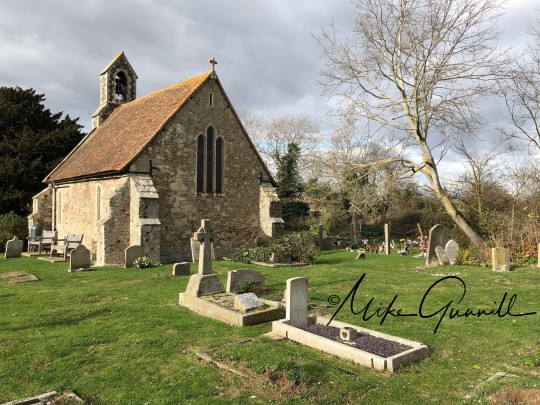
August 11th, 2019 marks 25 years since Peter Cushing died in Whitstable. Fondly remembered by the town, one question is still asked about the man. Where is he buried?
The location of Mrs Cushings grave and for that matter, the grave of Peter Cushing has been a mystery since his death in 1994. With twists, turns and secrecy, this present day tale wouldn’t be out of place from that of Cushing’s acting world.
The couple were very close, and he often spoke of his admiration for the support he received from his wife. From meeting in 1942 to Mrs Cushing’s death on January 14th, 1971 they were described by many as “ inseparable “ and had, an almost spiritual relationship. She was his companion while on film location or in the studio, helping with his lines and providing him with much needed encouragement and confidence. They were rarely apart and throughly enjoyed each others company.
Helen Cushing was buried locally to their home in Whitstable, and he always expressed a wish to be buried alongside her. I doubt they have been separated after death, as a couple they were so close, during their life together. This is not only logical but it doesn’t take much time reading about Peter Cushing to understand his total love, affection and deep gratitude to his wife. Frankly the thought of them buried apart, doesn’t make sense.
However as Peter Cushing might have said while starring as Sherlock Holmes, I will present my evidence and let the you decide!
Born as Violet Helene Beck in St Peterburg, Russia on February 8th 1905. Her parents were Ernest Beck, who was born in St Peterburg in 1875 and Helene Alexandra Fatimia Enckell born in 1879 from Hamina in Finland.
Miss Beck enjoyed a priviledged lifestyle, provided by her father ownership of the Maxwell Mills in St Petersburg. His father Jack Beck originally from Ashton, near Preston in Lancashire had moved with his family to Russia to establish the James Beck Spinnery Company. Many families relocated from Lancashire to manage mills, train new workers and helping to pioneer the Russian textile industry. With imported British machinery and experience, this venture was highly successful and profitable for the Beck family.
Helene, who disliked her first name of Violet, had two brothers, Reginald Ernest Enckell Beck, 1902-1992 and Godfrey Charles Beck, 1903-1972. Also two sisters, Marjorie Elizabeth Beck, 1908-1985 and Doris Rosalind Beck, 1910-1980.
Life was good in Russia for the British, but the local work force became to dislike the working conditions and long hours. The Ministry of the Interior formed a legal trade union for mill works to help quell their discontent. Trying to present a petition in January 1905, over 200 workers were killed during a protest demonstration by Cossacks. Although this revolution was brutially put down and failed, the working atmosphere within the country changed. The Beck family, for example, watched with concern, as the red army practiced manoeuvres in the woods, behind their house.
From the time of the failed revoltution in 1905, the Beck family continued to have problems with some of their workers. It was clear to all, that Russia was no longer a safe place to live and that major changes was coming. Leaving most of their wealth behind, the family, in small groups hastily departed around 1911.
Returning to England, Helen Beck found work as a tutor, and later became a chorus girl which led to work in the theatre as an actress. She married Kenton Redgrave Kreitmayer in 1929 in Kensington. She lost a child in the final stages of pregnancy, which also removed the chance of further children. Kenton who dropped his surname of Kreitmayer by deed poll to use his middle name of Redgrave. He had previously been married to Vera Elizabeth Kathleen Hemingway, the daughter of John Hemingway. This marriage ended in scandal when she was divorced after admitting adultry to two men.
Peter Cushing lived in Brentwood, Los Angeles while looking for film work, but returned to England on the White Star ship, Tilapa from Halifax, Canada to Liverpool, on March 27th 1942. He gave the address of Cherry Tree Cottage, Horley Surrey as his permanent address in England. He needed to find work quickly and was accepted into the Entertainments National Service Association, in April 1942
Known professionally as Helen Beck, she first met Peter Wilton Cushing as a replacement actress for the Noel Cowards play, Private Lives. Sonia Dresdel 1909-1976 had to leave the tour because of the constant performing and travelling. Something that both Helen and Peter Cushing was suffer from,later. Miss Dresdel went on to become a leading actress in the West End, in films and later on television. She retired to Ransley Cottage, a grade 2 listed property in Kingsford Street, Mersham near Ashford, where she died on January 18th, 1976. Helen Beck took over, the leading role of Amanda Prynne. Cushing had secured the male lead role of Elyot Chase, and they played a recently divorced couple. They found themselves thrown together in this comedy of Noel Coward manners when they both realise that their divorce may have been a mistake.
Meeting to catch a bus at the Theatre Royal in Drury Lane,London for their first performance in Colchester they met at the stage door. Helen later said she thought they had met or she known “this man “ before. Quoted in later life she said,” I knew I would love him for the rest of my days and beyond.”
From May 1942 the company toured for ENSA, entertaining troops throughout the United Kingdom. This tour included the towns of Colchester, Wolverhampton, Oxford, Taunton, Oswestry, Canterbury and Dover. The tours were hard work, with all experiencing long hours. While lodging in Bridge during the Canterbury performances, Helen became ill and had to miss some of the booked shows. Soon after Peter fell ill and they both left the touring group.
They became inseparable after the theatrical tour, and Helen quickly became the centre of Peter’s life. With only her parents present as witnesses, the couple married on the 10th April 1943 at Kensington Register Office in London. According to the wedding certificate Violet Helene Redgrave was 37 years, the divorced wife of Kenton Redgrave and Peter Cushing, 29 years, was a batchelor. Both gave their address as, 18 Bullingham Mansions, Church Street, in Kensington.
Helen gave up her career, to help Peter and continued to coach and suggest new area’s of work for Peter throughout her life. This included Shakespeare, and when times were hard, working for BBC Television. Peter starred in Pride and Prejudice as Mr Darcy, as Winston Smith in George Orwell’s play 1984 and as the series, Sherlock Holmes in 1968. He appeared with Morecambe and Wise, between 1969 and 1980 in a long running comedy sketch, where he was trying to locate his missing £5 fee from appearing on the first show.
In 1969 they moved from old converted stables, a small two bedroom property at 9 Hillsleigh Road, Holland Park, London to Whitstable. Friends had mentioned a white boarded cottage right on West Beach, a short distance from the town. The move was mostly for Helen’s health, as it was hoped the move away from London to Seaway Cottages would help with its fresh sea air. This proved not to be the case and despite nursing by Peter, Helen Cushing died at their Whitstable home of emphysema in 1971. Helen had only been in Whitstable less than 2 years.
On her death, Helen Cushing left Peter a note.
< Do not pine for me, my beloved Peter because that will cause unrest, do not be hasty to leave this world, because you will not go until you have lived the life you have been given and remember, we will meet again, when the time is right, that is my promise.>
The personal letter, provided by Peter Cushing was quoted for the first time in 1990, by Canterbury film maker Peter Williams, MBE in his television series: The Human Factor, ‘For The Love of Helen.’
Helen died on the Thursday at 9.02 am 14th January 1971, and after a service was held at Barham Crematorium near Canterbury her ashes were later interred in Seasalter.
Peter revealed in a later autobiography, that he ran out. on to the wet, windy beach in front of their cottage immediately after her death. He then returned and ran up and down the stairs, as if trying to induce a heart attack with the greive. Peter Cushing would continue to morn for his wife, for the rest of his life.
Peter Cushing mentioned, several times after her death, noteably in a 1972, Radio Times interview, said that he wished to join her.
During the interview he insisted with the writer, that he should include his comments, adding:
“To join Helen is my only ambition. You have my permission to publish that, really, you know dear boy, it is all just killing me. Please say that.”
In 1985 Peter Cushing wrote a personal note to the television programme, Jim’ll Fix It. Jimmy Saville returned an earlier favour and granted his wish to have a rose created in his wife’s name. Christopher Wheatcroft cultivated the rose as a one off commission, a mix of the verttities, Silver Jubilee and Deep Secret, produced in pink. Peter appeared on the show sitting next to Jimmy Saville and got his wish, a new rose called, The Helen Cushing.
The Cushing’s used to have a huge garden in Whitstable, stretching behind most of Seaway Cottages, down to the road, Island Wall. The landscaped garden with a white shed, contained plants and roses and a local man assisted with the maintainance. The garden has long gone, sold off and cleared to provide for another house on the corner and larger cottage gardens. The special pink rose must still exsist, perhaps with Mrs Broughton?
A seat from his garden was later presented to the towns people of Whitstable in 1992 and is located at what is now known as, ‘Cushings View’. Situated in front of Keam’s Yard, car park and looking out to sea. It was a spot Peter Cushing loved, and he used to walk or ride his bicycle along the seawall from his cottage, a short distance away.
Details on the bench are : < Presented by Helen and Peter Cushing, who love Whitstable and it’s people, so very much.>
His wife was included on the inscription even though she had died 21 years earlier , Peter always used her name when sending Christmas cards and personal letters, and signed off as, ‘Helen and Peter’.
Steve Coneys was the vicar at the time at St Alphege Church, Seasalter and remembers Mrs Cushings death. She was placed by the north wall of the church, where other ashes have been interred. Asked about the rumour that her remains had been moved on Peter’s wishes, Reverend Coneys said:
“ For that to happen an exhumation order should have been obtained. I should have been aware of that. I do not recall that being the case.”
A headstone placed soon after her death, with a poem from her husband was removed after Peter Cushing’s death. Today the grave is difficult to find and the remaining inscription is not readable. Peter Cushing always stated he wished to buried with his wife and after his cremation at Barham, many including the The Independant newspaper reported that “ Seasalter Church was his last resting place “, in his obitary. While visiting his wife, sometimes on his bicyle, Peter always sat on the green wire bench a little distance from the grave. One day he was concerned that an unknown visitor had placed flowers on her grave and this deeply troubled him. He also knew that local church officials had often removed notes and requests for his autograph from her grave.
It seems, at this point in his life he may have changed his own funeral plans, or at least some of the arrangements. It was clear, he didn’t want to create a shrine in the churchyard and certainly didn’t like the fuss surrounding film star, whether dead or alive. Seasalter residents recall seeing him, visiting, sometimes on a daily basis. He would be reconised of course, but during his visits, he would talk to others, rarely. One churchyard visitor said, he spoke one day to me, about the weather. I was lucky, as he often seemed very deep in private thought. He would always tip his hat, to the ladies, he was a wonderful gentleman.
Peter Cushing lived with the Broughton family in Hartley near Longfield, Kent on and off towards the end of his life. He spent less time at Seaway Cottages, where his house keeper, Maisie Olive had taken up residence, to be on call when needed. Mrs Joy and husband Bernard Broughton would take it,in turns to care and sit with him. One spending the night, the other sitting during the day. It was Peter himself who decided to enter the Pilgrims Hospice on London Road,Canterbury where he died on August 11th, 1994.
On Friday August 19th 1994, Whitstable town came to a standstill, many shops closed as a mark of respect. Led by Terry Davis of John Kemp Funeral Directors, using one of Peter Cushing’s own walking canes, led the funeral cortege. First to Cushing’s View, and then, to the Tudor Tea Rooms in Harbour Street - a favourite spot for Peter’s afternoon tea and cakes. The procession travelled along the High Street with many residents following behind while in the town, and then on to Barham Crematorium for a final private ceremony.
Terry Davis, who now has his own funeral business in Cornwallis Avenue in Aylesham, remembers the day with pride. From his company web site he notes: “ I will always remember 1994. I had the privilege to conduct Peter Cushing's funeral in Whitstable. The High Street was crowded by the general public wanting to pay their respects, this was a fitting farewell to a first class actor of his era.”
On January 12th 1995, a memoral service was held in St Paul’s Church, Covent Garden attended by friends, family and fellow film stars. Christopher Lee and Ron Moody read the lessons.
The normally sedate Whitstable and Herne Bay Times newspaper, published a front page story on Thursday, 15th June 1995. Under the headline ‘ Cushing Grave Mystery’, it repeated concerns of some local residents in the town about the location of his grave. In reply to the story, his secretary from 1959, Mrs Joyce Broughton of Hartley and Faversham said: “Mr Cushing asked us to place him somewhere private.”
“ He was a very private man and did not like all the fuss and attention he was given.”
“ He is now in a private place. It was what he wanted and I have simply carried out his wishes.”
The story was followed up by the News of the World and the Sunday Times newspapers, which only added to the mystery and was also widely condemmed for it’s speculation, by Cushing friends and fans.
After his death, Mrs Margaret Broughton and her husband, Bernard Broughton were left the entire Peter Cushing Estate. A company Peter Cushing Productions Limited had been formed earlier with Mr Broughton as a Director and Company Secretary and Mrs Broughton as a director. As well as helping displays and background details on the life of Peter Cushing, the trust gave permission for The Star Wars franchise. They wanted to use, an image of Peter Cushing in the film,20 years after his death. A computer generated image was digitally created for the Star Wars, Rogue One film, after Cushing had previously appeared in the 1977 film, Star Wars, New Hope. Many were not sure about the CGI-resurrection, but the company said Peter Cushing had been proud of his Star Wars connections, and the work had been done with a great deal of affection. “ We would never have proceeded without the backing and approval of Cushing trust officials”, added an official press statement.
Helen and Peter Cushing are still a part of Whitstable and are remembered with a great deal of affection. The town allowed the couple and later Peter in his grief, to live a near normal life, by just leaving them alone. For this, the couple both recorded their thanks, many times. It came as a shock to many, that that towns folk couldn’t pay their respects to the actor and his loving wife, not knowing the location of their final resting place.
The anicent church of St Alphege, known affectionaly as “the Old Church’ in Faversham Road, Seasalter must hold the mystery of where Peter Cushing is buried. The church has known many mysteries from origin in 1023 to the present day, but much like Mrs Joyce Broughton, isn’t revealing anything.
13 notes
·
View notes
Text
SAINT OF THE DAY (April 19)
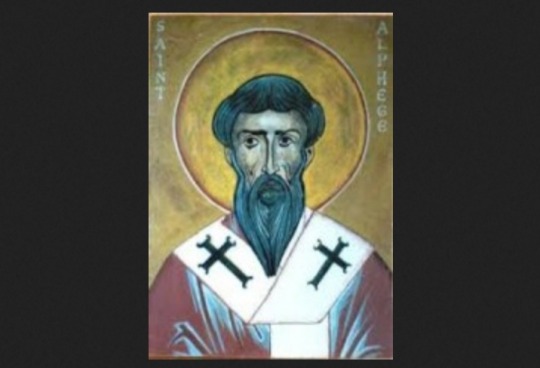
Alphege was born in 954 in Weston, on the outskirts of Bath.
He became a monk early in life.
He first entered the monastery of Deerhurst. He then moved to Bath where he became an Anchorite.
He was noted for his piety and austerity, and quickly became the Abbott of the Abbey in Bath.
In 984, he became the Bishop of Winchester.
While Bishop, he was largely responsible for the construction of a large organ in the Cathedral, audible for over a mile away and said to require more than 24 men to operate.
He also built and enlarged the city’s Churches.
In 1006, he became the Archbishop of Canterbury.
He went to Rome to get his Pallium from Pope John XVIII and was robbed during his journey.
In 1011, the Danes raided England, and from September 9 to 29, they laid siege to Canterbury.
Alphege, the Bishop of Canterbury, was taken captive for seven months.
The Bishop of Rochester and the Abbess of St. Mildrith’s were also captured, but the Abbot of St. Augustine’s Abbey managed to escape.
They then set fire to the Canterbury Cathedral and destroyed it.
Alphege refused to allow a ransom to be paid for his freedom, and as a result, he was killed on 19 April 1012 at Greenwich (now a part of London), on the site of St. Alfege’s Church.
He was the first Archbishop of Canterbury to die a violent death.
Some sources say his death was so violent that a Christian convert, known as Thrum, delivered the back of an axe to his head as an act of kindness.
He was buried in St. Paul’s Cathedral, and his body was later moved to Canterbury.
After his death, many conversions came about with the soldiers who carried out his gruesome death.
He is a martyr for the faith. His feast day is April 19th.
12 notes
·
View notes
Text
220520 • 1:23pm 🏙
Touring Nairn’s City of London: northern and western edges. I seized a sunny day to go see some of Ian Nairn’s destinations and more.

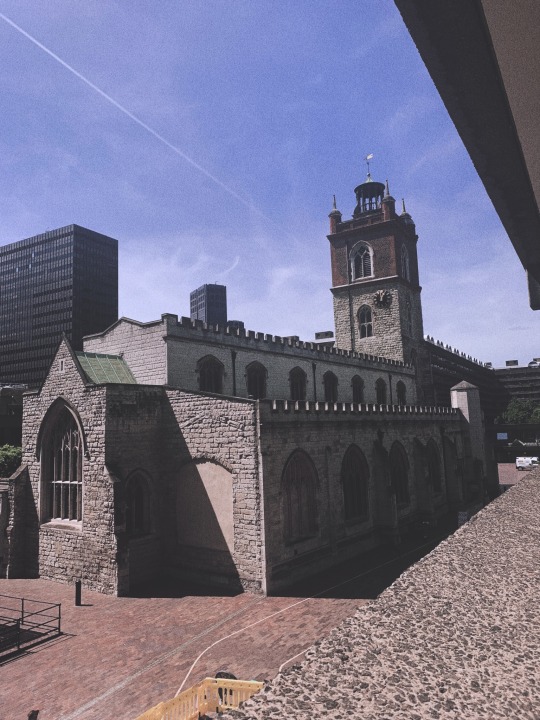
The Barbican is a good first stop, a lovely bit of City Brutalism (though maze-like). I find Brutalist buildings so attractive when complemented by sunshine. Enjoyed visiting the book fair at St Giles-without-Cripplegate! Wonderful prices and selection with new stock coming in, plus it’s in a sweet little church.
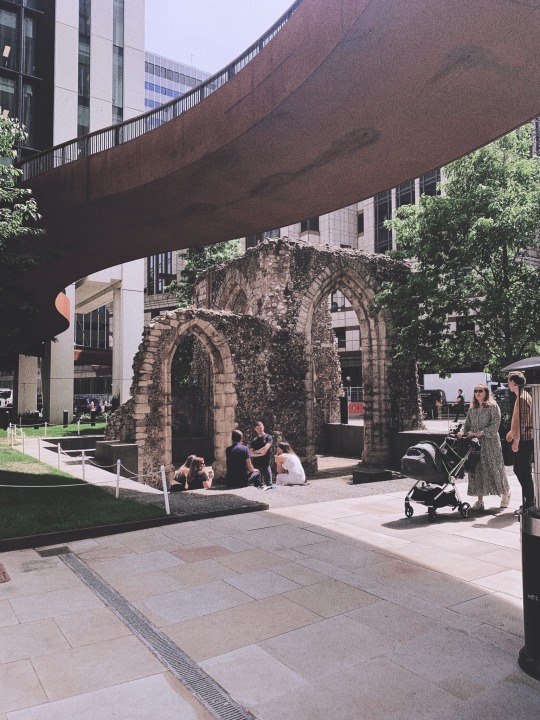

Depending on how you leave the Barbican, you may come across St Alphege London Wall. I’m quite fond of ruins - there is a wistful charm to the fragmented identity of what once was. Broadgate has an amusing (and inadvertent?) modern homage to St Alphege.
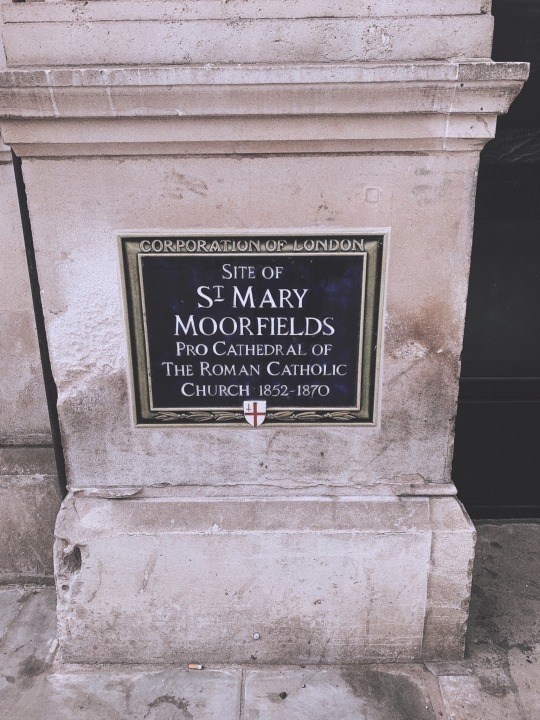

Following Nairn, we head to Finsbury Circus for Lutyens’ Britannic House. Coming from Broadgate, the keen eye might notice a commemoration plaque for the old St Mary Moorfields. I’ve probably seen Lutyens around, but this is the first time I’ve consciously visited one of his works; don’t know much about him but the statues and classical details were charming.
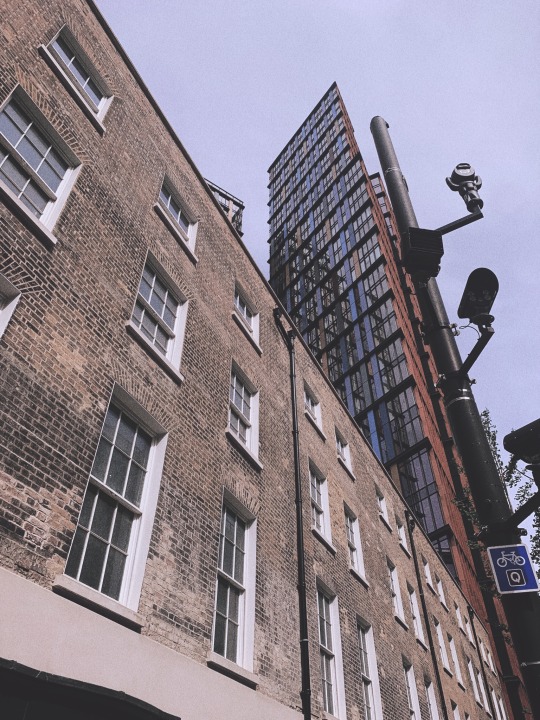
We now come to a blooper in my tour. When I mapped out Nairn’s route, I erroneously put down Sun Street rather than Sun St Passage. Nevertheless, it is fascinating to walk down; you fancy the yellow bricks quiver in the face of One Crown Pl.

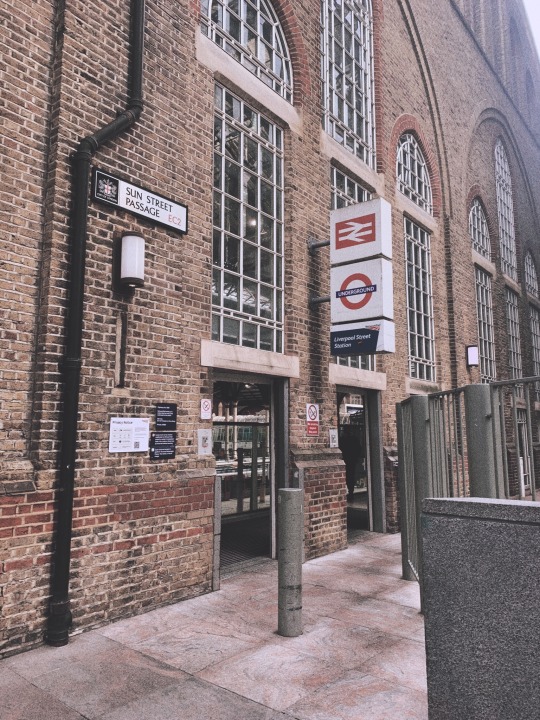
Exchange Square is a good place to stop and spend a sunny afternoon in. From there, the actual destination of Sun St Passage leads to Liverpool St station. Bit disappointed when I couldn’t find the peek at Hawksmoor’s Christ Church as Nairn described - a consequence of the City’s endless expansion perhaps? The City bleeds further into its surroundings, melting old boundaries with its ever increasing strength of commerce. Is it for better or worse? Maybe only time will tell. Those clusters of glass towers certainly feel a little menacing sometimes.

As I caught my bus, a view of St Botolph-without-Bishopsgate concludes the trip. It’s one of the 3 St Botolphs in the area; there’s also Aldgate and Aldersgate. Whew! Church names amirite. (City church tour eventually, I promise.)
☞ studygram
#studyblr#studyblr community#archiblr#architecture studyblr#architecture student#bookblr#dark academia#dark academia aesthetic#light academia#light academia aesthetic#writing#venetianwindow#heyzainab#studyvan#astudentslifebuoy#huitingreads#myhoneststudyblr#nihaohoney#heysantiago#heypeachblossom#architectingly#tusermelissa#problematicprocrastinator
26 notes
·
View notes
Text

Princess Anne opening The Blackfriars Youth Centre in St Alphege's Hall Rushworth Street, London.
31 notes
·
View notes
Text
The Book in the Cathedral by Christopher de Hamel review – adventures of a manuscript sleuth
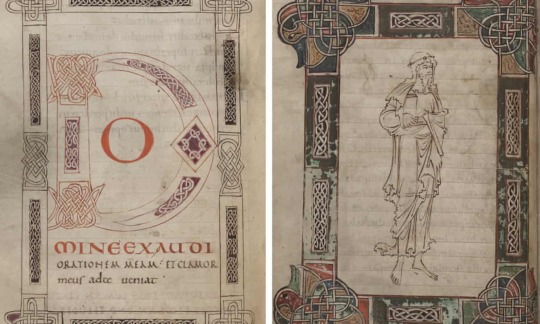
On Christmas Day 1170, Thomas Becket delivered a sermon to a packed chapter house at Canterbury. His theme was the death of one his predecessors as archbishop, St Alphege, hacked to death by the Danes in the early 11th century – the only martyr in the role so far. “There will soon be another,” Becket declared. Four days later, a quartet of knights arrived drunk, on a perceived mission from the king, and dashed the archbishop’s brains across the cathedral floor. It is easy to see how, knowing his time was up, Becket might identify with Alphege. In The Book in the Cathedral, however, Christopher de Hamel argues that the two had something more tangible in common: an elaborately jewelled psalter – a book of psalms – once owned by Alphege and later treasured by Becket.
De Hamel – author of the wonderful Meetings With Remarkable Manuscripts – shows us all the tools of the bibliographer’s trade: dating handwriting, identifying pigments, noting the rust marks left by nails from a now-lost ornate binding.
The cult that sprang up around Becket after his death spread widely and swiftly. Within three years he was Saint Thomas, and Canterbury would become one of the most visited pilgrimage sites in Europe. When the Reformation came, however, Becket fell out of favour, his relics – bones, clothes, a soiled handkerchief – destroyed as the baggage of an old form of superstition. One curious quirk of relic veneration is that books rarely make the cut. Becket’s library then, shelved unassumingly in a passageway in the cathedral, was spared the reformers’ zeal. Instead it was cherrypicked by Matthew Parker, archbishop to Elizabeth I, who in turn left his own library to his former college at Cambridge.
READ MORE
32 notes
·
View notes
Text
Notre-Dame de Fourvière Basilica / Our Lady of Lyons, France (1643), Memorials of the Saints and a Prayer to St Edepitus in Urgent Need - 19 April
Feria Day – Wednesday in the Second Week of Easter
Notre-Dame de Fourvière Basilica / Our Lady of Lyons, France (1643) – 19 April:HERE:https://anastpaul.com/2021/04/19/notre-dame-de-fourviere-basilica-our-lady-of-lyons-france-1643-and-memorials-of-the-saints-19-april/
St Alphege of Winchester (c 953–1012) ArchBishop and Martyr, Monk, Hermit, Abbot, Teacher, Apostle of charit, His body is…
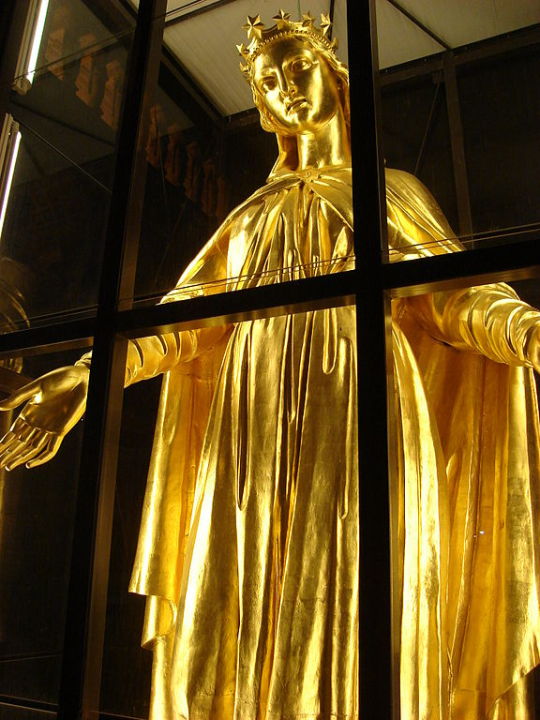
View On WordPress
#blbernardofsithiu#blconradofascoli#bljamesduckett#OURLADYOFLYONS#prayertostexpeditus#saints19april#stalphege#stexpeditus#stpopeleoIX
4 notes
·
View notes
Text
Today the Church remembers st.Alphege of Canterbury, Archbishop, Monk, and Martyr.
Ora pro nobis.
St. Alphege, also known as Ælfheah, was born around 953 AD, supposedly in Weston on the outskirts of Bath, and became a monk early in life.”He first entered the monastery of Deerhurst, but then moved to Bath, where he became an anchorite. He was noted for his piety and austerity and rose to become abbot of Bath Abbey. Indications are that Ælfheah became abbot at Bath by 982 AD, perhaps as early as around 977. He perhaps shared authority with his predecessor Æscwig after 968.
Probably due to the influence of Dunstan, the Archbishop of Canterbury (959–988), Ælfheah was elected Bishop of Winchester in 984,l and was consecrated on 19 October that year. While bishop he was largely responsible for the construction of a large organ in the cathedral, audible from over a mile (1600 m) away and said to require more than 24 men to operate. He also built and enlarged the city's churches, and promoted the cult of Swithun and his own predecessor, Æthelwold of Winchester. One act promoting Æthelwold's cult was the translation of Æthelwold's body to a new tomb in the cathedral at Winchester, which Ælfheah presided over on 10 September 996.
Following a Viking raid in 994, a peace treaty was agreed with one of the raiders, Olaf Tryggvason. Besides receiving danegeld, Olaf converted to Christianityl and undertook never to raid or fight the English again. Ælfheah may have played a part in the treaty negotiations, and it is certain that he confirmed Olaf in his new faith.
In 1006, Ælfheah succeeded Ælfric as Archbishop of Canterbury, taking Swithun's head with him as a relic for the new location. He went to Rome in 1007 to receive his pallium—symbol of his status as an archbishop—from Pope John XVIII, but was robbed during his journey. While at Canterbury, he promoted the cult of Dunstan,lordering the writing of the second Life of Dunstan, which Adelard of Ghent composed between 1006 and 1011. He also introduced new practices into the liturgy, and was instrumental in the Witenagemot's recognition of Wulfsige of Sherborne as a saint in about 1012.
In 1011, the Danes again raided England, and from 8–29 September they laid siege to Canterbury. Aided by the treachery of Ælfmaer, whose life Ælfheah had once saved, the raiders succeeded in sacking the city. Ælfheah was taken prisoner and held captive for seven months. Godwine(Bishop of Rochester), Leofrun (abbess of St Mildrith's), and the king's reeve, Ælfweard were captured also, but the abbot of St Augustine's Abbey, Ælfmær, managed to escape. Canterbury Cathedral was plundered and burned by the Danes following Ælfheah's capture.
Ælfheah refused to allow a ransom to be paid for his freedom knowing the poverty of the people, and as a result was killed on 19 April 1012 at Greenwich (then in Kent, now part of London), reputedly on the site of St Alfege's Church. The account of Ælfheah's death appears in the E version of the Anglo-Saxon Chronicle:
... the raiding-army became much stirred up against the bishop, because he did not want to offer them any money, and forbade that anything might be granted in return for him. Also they were very drunk, because there was wine brought from the south. Then they seized the bishop, led him to their "hustings" on the Saturday in the octave of Easter, and then pelted him there with bones and the heads of cattle; and one of them struck him on the head with the butt of an axe, so that with the blow he sank down and his holy blood fell on the earth, and sent forth his holy soul to God's kingdom.
Ælfheah was the first Archbishop of Canterbury to die a violent death. A contemporary report tells that Thorkell the Tall attempted to save Ælfheah from the mob about to kill him by offering everything he owned except for his ship, in exchange for Ælfheah's life. Ælfheah was buried in St Paul's Cathedral. In 1023, his body was moved by King Cnut to Canterbury, with great ceremony. Thorkell the Tall was appalled at the brutality of his fellow raiders, and switched sides to the English king Æthelred the Unready following Ælfheah's death.
When the Dane Cnut (Canute) became King of England in 1016, he adopted a policy of conciliation, and in 1023 he brought the body of Alphege from London to Canterbury, where he was long remembered as a martyr.
O Almighty God, by whose grace and power thy holy martyr Alphege triumphed over suffering and was faithful even unto death: Grant us, who now remember him with thanksgiving, to be so faithful in our witness to thee in this world, that we may receive with him the crown of life; through Jesus Christ our Lord, who liveth and reigneth with thee and the Holy Spirit, one God, for ever and ever. Amen.

#christianity#jesus#god#saints#salvation#martyrs#father troy beecham#troy beecham episcopal#father troy beecham episcopal
5 notes
·
View notes
Photo
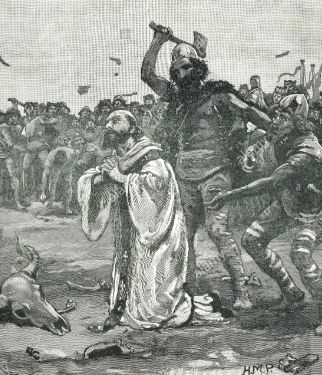

Ælfheah of Canterbury 954 – 19 April 1012 He is also known as Alphege
Born in 954 near present day Bath, England, Ælfheah ( translates as elf-high) was the Anglo Saxon Bishop of Winchester (984) and later Archbishop of Canterbury (1006). . Picture above shows his burial place in Canterbury Cathedral beside the High Altar
In the aftermath of a Viking raid in England, a peace treaty was signed with one of the raiders - Olaf Tryggvason. Along with receiving Danegeld (a tax paid to viking raiders to save the land and its people) Olaf converted to Christianity, promising never to raid or fight in England again. Ælfheah almost certainly played a role in his confirmation.
In 1011, Vikings once again raided England, laying siege to Canterbury, plundering and destroying the cathedral.
Ælfheah was taken captive along with many others (probably to be sold as slaves) and held prisoner for seven months. He refused to allow any money to be exchanged for his freedom and as a result was killed on the 19th of April 1012. He was the first Archbishop of Canterbury to die a violent death, but not the last, Thomas Becket prayed to Ælfheah shortly before his own murder in Canterbury Cathedral in 1170.
The Anglo Saxon Chronicle gives this account of his death:
… the raiding-army became much stirred up against the bishop, because he did not want to offer them any money, and forbade that anything might be granted in return for him. Also they were very drunk, because there was wine brought from the south. Then they seized the bishop, led him to their “hustings”on the Saturday in the octave of Easter, and then pelted him there with bones and the heads of cattle; and one of them struck him on the head with the butt of an axe, so that with the blow he sank down and his holy blood fell on the earth, and sent forth his holy soul to God’s kingdom. So appalled at the brutality of his comrades, the Viking Commander Thorkell (The Tall) offered all of his possessions, excluding his ship in exchange for Ælfheah’s life.
He was buried in St Pauls Cathedral, however, in 1023 his body was moved by King Cnut (Canute) to Canterbury Cathedral, Ælfheah was canonised a saint in 1078.
89 notes
·
View notes
Text
Churches!
Over the last couple of days Chrissie and I have been visiting all the churches that were places where English Beach family members were married, baptised or buried.
St Laurence, Alvechurch
Job Marston Chapel
St James the Great
St Alphege
Lots of pics of both inside and outside!😁
1 note
·
View note